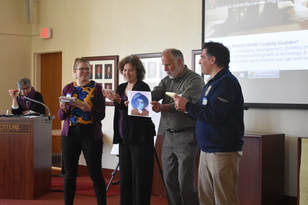By Linda Norris, Museum Maverick for the Western NY Session University art collections present particular challenges — and opportunities -- for innovative interpretation. At the Regina A. Quick Center for the Arts at St. Bonaventure University. 17th century religious paintings, 19th century landscapes and 20th century Warhols all exist together. It’s like a tapas menu—small bites of lots of different things. Add to that mix a bit of everything in terms of participants—from history museums to arts organizations—and it was a chance to literally and figuratively mix it up. As a presenter, this gave me a chance to mix it up as well. Presenters as Activators As a presenter, there are always those first few moments when you’re puzzling out a room full of participants: will they want to try activities? What will they find in common? Are they lively or will they stand there with their arms crossed? My two big lessons as a presenter are:
We began with a bit of music and networking, sharing each other’s stories about passions (inside and outside of work) and incubation (where do you go to let your ideas incubate). This bit wraps around the theory of creativity, which, as anyone works to enhance their creative practice, is useful to know. Understanding the steps in any creative process provides the chance to share the process with others in a workplace and to adjust planning and implementation steps.
Mihaly Csikszentmihalyi in Creativity: Flow and the Psychology of Discovery and Invention, 1997 describes the creative process:
The emphasis in this workshop was on learning tools that can be used when participants were back at work—but not making them feel like tools, but like fun. What does fun look like? Check out the photos from this workshop and see. And always remember, there is no research anywhere that says any of us learn best by sitting and listening to a lecture. If you’re a presenter, think about different kinds of learners and consider individuals’ whole selves: their physicality, their emotions, their internal and external lives. Active Participants A key idea of this workshop was that creative combinations—creating mash-ups of different materials into something new are way to think more deeply about museum collections and community engagement. For the first mash-up, small groups got an image from the collection, a group of songs to choose from and the theme of power—and then they had to write and perform a song that used all those together. What would you do given an Andy Warhol print of high heels, the theme of power and a choice of songs ranging from "Call Me Maybe" to "Uptown Funk"? Perhaps your group would do a great, women-centered "Uptown Funk" version about those high heels as power. Mash-up #2 broadened out to include both current community issues specific audiences, and the painting collection (which ranged from medieval religious pieces to early 20th century American works. What issues are current in Western New York communities? Gentrification, loss of family farms, fracking, and immigration - are just a few of the topics considered. Small groups were assigned an artwork and a community issue and challenged to brainstorm a program or exhibit connecting those two seemingly disparate things. The goal was to create a program or exhibit that really looked at that problem, using that artwork. An artwork you might dismiss for one reason or another became a key to unlocking new understandings. After all, aren’t Mary and Joseph in a religious painting refugees fleeing a repressive regime? A bucolic farm scene can be used to talk about everything from gentrification to right-to-farm laws. An interior showing a television led to a program idea for teenagers about the ways families communicate (or don’t). In both mash-up activities, it was clear that the vital ingredient was the small group work. Groups were mixed each time, and we saw that different groupings led to new insights and new ideas. It’s a takeaway about how important it is to break out of our silos, both within and outside of our museums. Serious Fun The entire day was filled with lots of laughter as participants enthusiastically dove into every challenge set to them. But it was serious fun. New problems arise in our communities and our nation every day—and museums can be centers for not just art appreciation, but centers for activism and change. Approaching our work as serious fun can make that happen.
0 Comments
Your comment will be posted after it is approved.
Leave a Reply. |
Archives
October 2020
Categories
All
|
 RSS Feed
RSS Feed